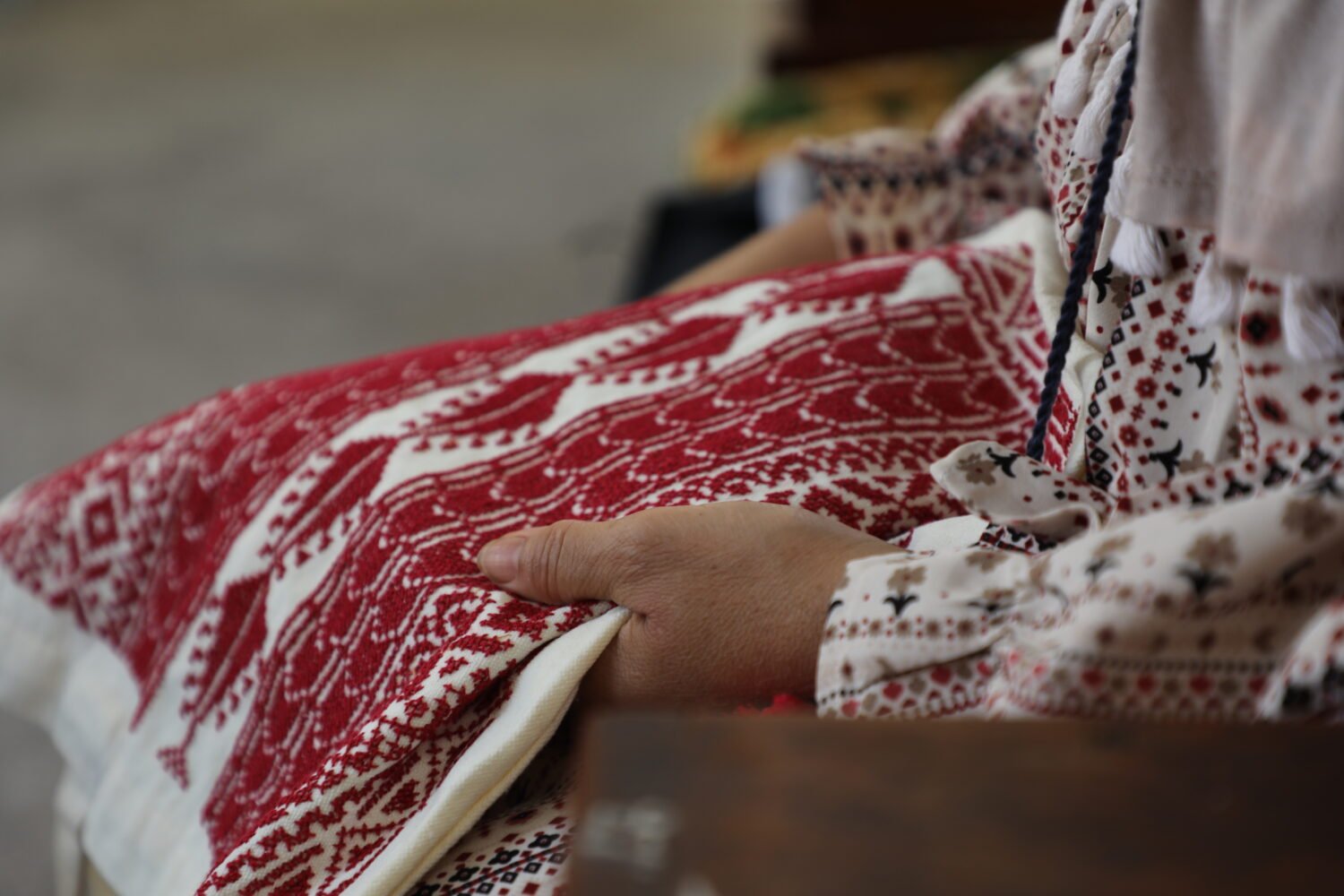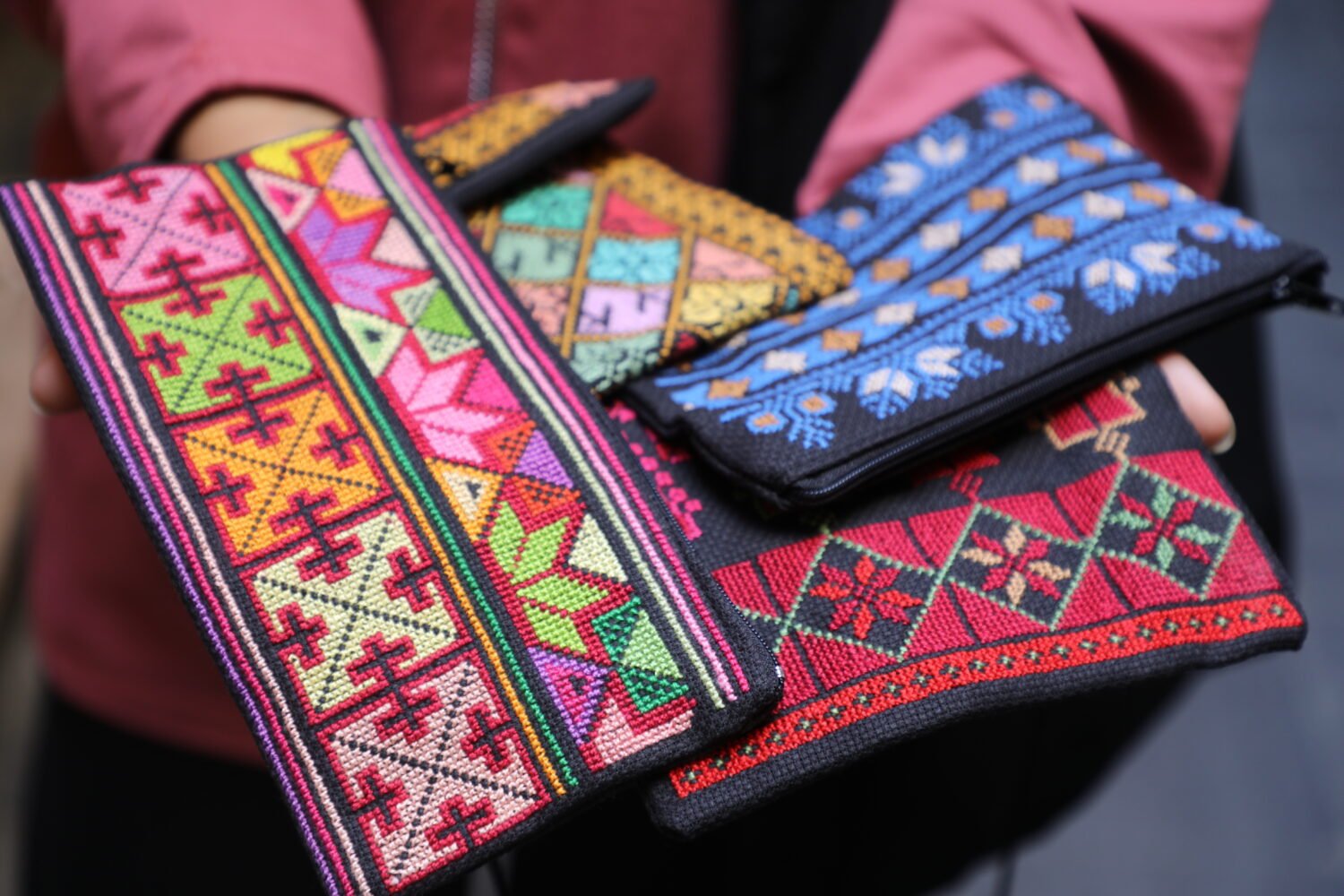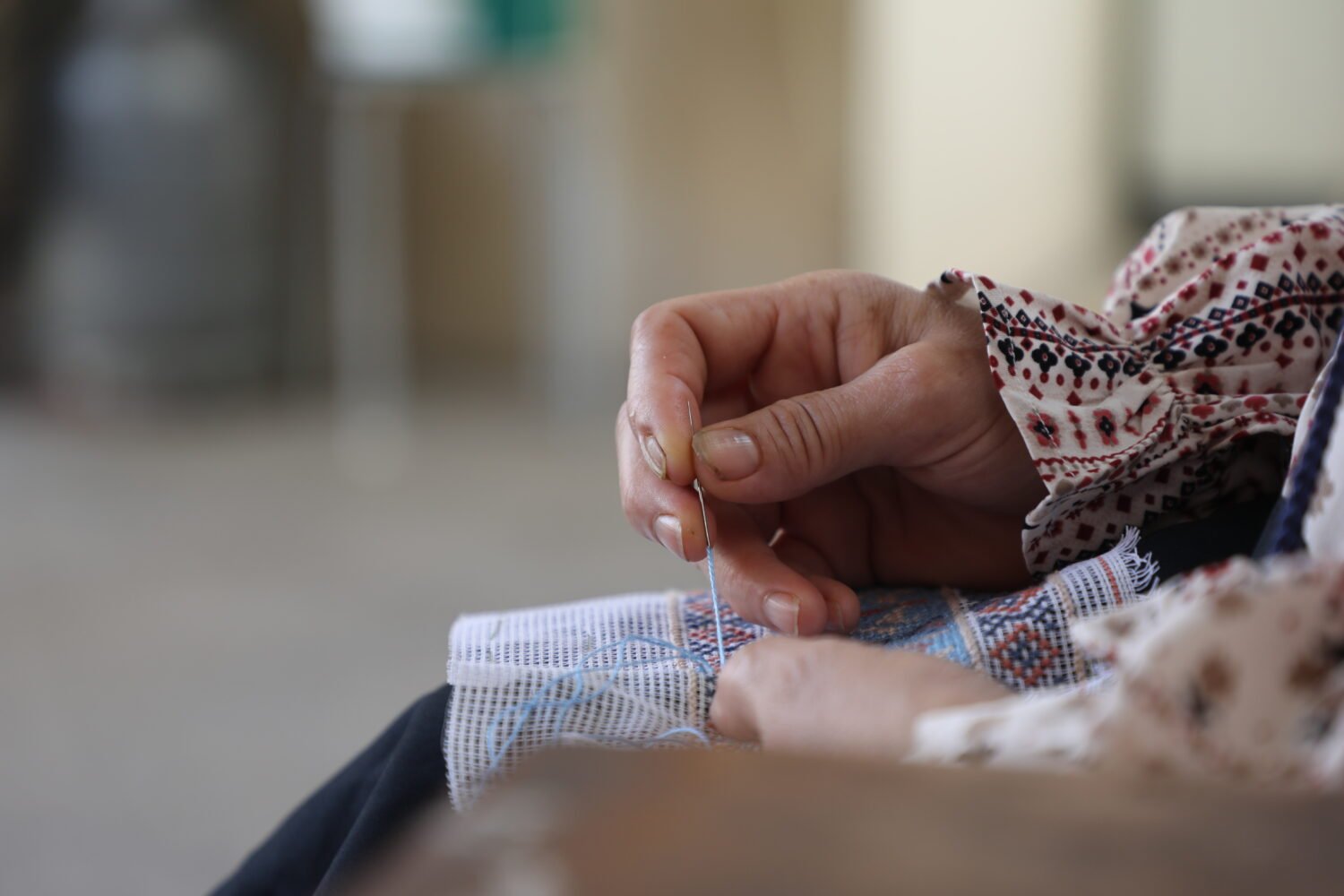Tatreez, an ancient craft practiced by Palestinian women, serves as a means to preserve cultural heritage and showcase history.

Dana Hourany
In the bustling Palestinian refugee camp of Ein el-Helwe, southeast of Saida, Bouthayna used to spend hours immersed in her favorite hobby – the art of Palestinian embroidery, known as tatreez.
Having learned the craft three decades ago at an UNRWA school, she successfully transformed her passion into a profitable business. In September of last year, however, fierce clashes between different Palestinian factions in the camp brought her work to a halt.
“Shortly after that, the Israeli war on Gaza began in October 2023, and people were no longer interested in buying embroidered garments,” Bouthayna told Fanack.
Despite her love for tatreez, this once pleasurable pursuit has become a financial burden. In parallel to the war, Lebanon’s ongoing economic crisis means that the cost of raw materials continues to skyrocket.
“Every time I buy material, I have to pay slightly more to the point where it has simply become unaffordable,” she said.
Tatreez, an ancient craft practiced by Palestinian women, serves as a means to preserve cultural heritage, showcase history and strengthen community bonds while helping refugee women in the shatat (diaspora) generate income for themselves and their families. Palestinian women who arrived in Lebanon after the 1948 Nakba ensured its continuity, passing down the art to younger generations. This enduring tradition, however, faces a number of challenges that force it to take on new forms in order to survive.
Tatreez originated in Palestine over 3,000 years ago. It is a unique embroidery practice that combines colored threads to create traditional motifs. These designs are region-specific and hold symbolic significance for events like weddings or pregnancies.
Colors are also used to indicate different life stages; for instance, in al-Khalil, green is reserved for younger women, while purple signifies older age. Regional differences are expressed through varying shades, such as Ramallah’s bright red compared to al-Khalil’s brownish red.
Around the age of six or seven, young Palestinian girls begin training in this women-led art form, where embroidery is not only a skill but also a means of self-expression and representation of girl and womanhood. Tatreez sessions serve as an opportunity for young girls to learn life stories, skills, and wisdom from their elders.
Tatreez involves various techniques, including the cross-stitch method, known as quṭba fallāḥiyya, which is the most commonly used and symbolic of Palestinian heritage. The diversity in designs often signifies the maker’s village and draws inspiration from the Palestinian landscape.
The stitches usually depict local plants like cypress trees (sarū), palm trees (nakheel), and the S-shaped rubus (ullayq). Fruits and vegetables specific to the maker’s village act as indicators of the place of origin, along with well-known symbols like the moon and eyes, symbolizing well-being, wealth, and protection.
For instance, designs with orange blossoms represent the village of Beit Dajan, and patterns of flowers and leaves indicate a connection to farming or gardening within the village or family.
As Palestinians faced forced expulsion from their homes in 1948 and again in 1967, many women maintained a tangible link to their hometowns by wearing and safeguarding the tatreez thobes. During this time, tatreez underwent a transformation driven by economic and political constraints, particularly in refugee camps. Women adapted by using more affordable cotton and incorporating machine embroidery techniques.
Between 1987 and 1993, following the first Intifada, a period of Palestinian resistance against Israeli occupation, Palestinian women created the ‘Intifada dress.’ These dresses resembled traditional thobes and bore prominent stitches of resistance, adorned with Palestinian symbolism such as national flags, maps, and natural motifs like olive branches and orange trees. Phrases like “we will return” or “our return” were weaved into the fabric in traditional Palestinian colors, representing an act of quiet yet visible resistance.
From Palestine to Lebanon

Despite their arduous and painful journey to Lebanon, Palestinian women carried the tradition of tatreez and worked on maintaining it. Although previous generations have practiced passing down the craft to younger generations, Bouthayna believes this practice might be dwindling.
“I sense that youngsters may lack the patience needed for the lengthy hours required to complete an embroidered piece,” she noted. “Plus, there’s a shortage of teachers as the women who know how to teach are getting older.”
Moreover, factories have replaced women, producing a flood of garments sold in Lebanese markets, she said. This shift led Bouthayna to sell abroad, believing Palestinians beyond Lebanon have the means of purchase, and value preserving their heritage.
“Here in Lebanon, there’s also fear of a potential full-blown war with Israel, and people in camps are cautious since various political factions reside here,” she went on to say. “That’s why I can’t risk taking larger orders in case of a war outbreak.”
Refugee camps in Lebanon face numerous challenges with high unemployment, poverty, and limited access to adequate education and health services, which adds to their vulnerability in case of escalated violence.
During internal camp clashes in Ein el-Helwe, many schools were targeted, Bouthayna said. Now, students are crowded into UNRWA schools outside the camp, split into morning and afternoon shifts, significantly affecting education quality and student morale.
Constant insecurity, coupled with the grief and anger from the war on Gaza, have amplified the struggles of Palestinian refugees in Lebanon. However, the war has also sparked renewed patriotism and interest in Palestinian culture and heritage, noted May Khashan, coordinator at the Palestinian Cultural Club (PCC).
“You can’t imagine how much demand there is for tatreez right now because people have started to see the victorious face of the Palestinian fight, not just that of the helpless and oppressed,” Khashan added.
Embroidered resistance

According to Khashan, the art of tatreez is experiencing significant changes in both design and technique. There’s a growing demand for tatreez on accessories like bracelets, earrings, tote bags, graduation hats, and blouses, as opposed to just traditional thobes which are now reserved for special occasions.
“Unlike older generations who wore thobes daily, the younger generation wants to carry this tradition with them every day, hence the demand for accessories,” Khashan said.
“We teach young women and children about the connection between tatreez and Palestinian identity from a young age, ensuring their interest lasts for years to come,” she said.
This is evident in Palestinian women reviving the tradition of henna nights before weddings, where brides and their female friends and family adorn traditional thobes or incorporate traditional embroidery into souvenirs and decorations at their weddings, Khashan added.
However, she notes that women who still engage in tatreez face challenges in making a livelihood solely from embroidery without the support of an organization.
“Women cannot solely rely on embroidery as a sole source of income. The materials are very expensive. While organizations can help in their cost, there are other factors that come into play,” Khashan said.
She points out that some organizations might exploit women by charging exorbitant prices for the products while paying their workers minimally.
“More awareness is needed around tatreez in that it is not just for galleries and exhibitions; it is an essential aspect of Palestinian identity,” she emphasized.
Continued tradition

One of the oldest associations dedicated to preserving Palestinian tatreez in Lebanon is “Inaash,” founded in 1969 by Huguette Khoury Caland, daughter of the first Lebanese president, Bechara el-Khoury. Huguette and other Palestinian women created the organization in an effort to protect Palestinian heritage and provide employment to refugee women.
Inaash currently employs over 350 women, producing a diverse range of items including abayas, coats, jackets, shawls, dresses, cushions, tableware, and various household accessories.
“Employing refugee women and protecting their heritage is a form of resistance that, if lost, would be akin to giving the Israelis a gift,” Ali Jaafar, Inaash’s director, told Fanack.
He adds that the association faced challenges in 2019 when they lost all their funds in Lebanese banks, hindering their ability to employ as many refugee women as preferred. However, they are now focused on fundraising efforts to expand and create more opportunities for Palestinian women.
“Despite the reduced purchasing power due to the Lebanese economic crisis, things have gradually improved, especially with the launch of our website, giving us an online presence abroad,” Jaafar said.
He mentions that Inaash has started providing public workshops, with plans for more in the future. Although their items have a higher price point, the director justified it by citing the high cost of raw materials as well as the significant care and time put into each piece.
He contends that during Christmas, people came in to buy embroidered items, demonstrating a sense of support and solidarity with Palestine in the wake of Israel’s war on Gaza.
Despite this renewed interest and passion for Palestine, residents of Lebanon remain concerned about the possibility of a full-scale war between Hezbollah and Israel. The two have been involved in intense clashes along the southern Lebanese borders, but as of now, it has not escalated to the levels witnessed during the 2006 war.
War and uncertainty

On January 11, US Presidential Advisor, Amos Hochstein, visited Beirut to engage in talks addressing the situation along the Lebanese southern border with hopes of finding a solution. Nevertheless, Hezbollah’s leader, Hassan Nasrallah, has insisted that tensions on the southern border will only ease if the war on Gaza ends.
In parallel, the United States and the United Kingdom began strikes against the Houthis in Yemen, who were attacking Israeli ships or ships heading to the ports of the occupied territories.
Lebanese political analyst Imad Salamey told Fanack that the Middle East is currently experiencing a unique regional war, unlike anything witnessed before. He elaborates that this war encompasses various arenas and is characterized by low-intensity conflicts rather than direct battles between two armies.
According to Salamey, this war involves numerous players and has no clear boundaries. Its duration is uncertain, but it is evident that highly developed weapons and economic conflicts, like those conducted by the Houthis on commercial ships, are pivotal parts of the conflict.
Regarding Lebanon, Salamey says that solutions are unlikely in the near future, especially considering Israeli officials’ statements that the war on Gaza could extend for months. He emphasizes that figures like Hochstein and other foreign diplomats do not hold the key to a direct solution but may help in calming tensions along the Lebanese borders to prevent further escalation.
“In case of a serious escalation, the war could expand to include Syria, Iraq, Yemen, and even Iran,” he said. “I believe that neither Hezbollah nor Israel want a full-scale war due to the high costs and significant losses it would entail for their territories and military infrastructure.”
A war with Hezbollah, he adds, would also not be advantageous for Israel as it would not be able to accomplish any meaningful political goals such as removing Hezbollah’s existence, while facing the possibility of slipping into a regional conflict involving multiple actors.
However, the situation remains uncertain and unpredictable. What is evident is the increasing appreciation and fascination with Palestinian heritage, particularly tatreez. It is not just Palestinians who are committed to preserving it, but also people worldwide who see it as a shared responsibility to protect this culture at all costs necessary.


